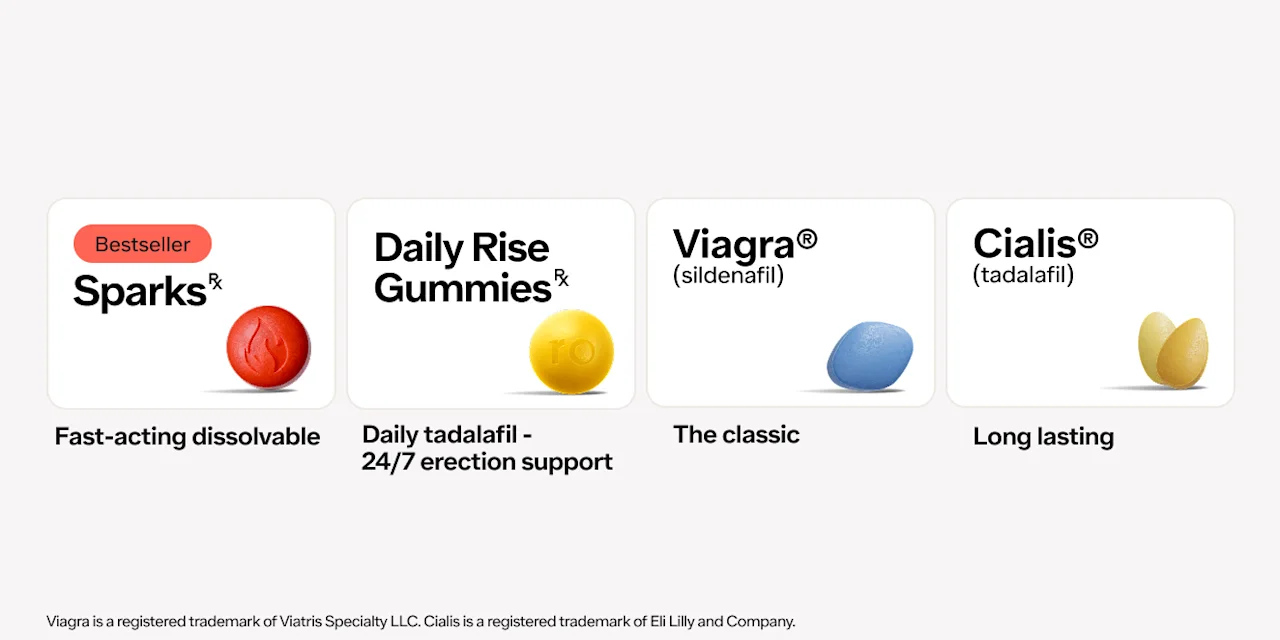Here's what we'll cover
Here's what we'll cover
Whether behind the register of your local gas station or in your spam inbox, we've all seen ads for “men's health” products promising virility and stronger erections (often in less delicate terms). If you struggle with erectile dysfunction (ED) and are frustrated with your sex life, some men consider taking the risk on a less-than-reputable product that allegedly helped them treat their ED. However, knockoff and unlicensed erectile dysfunction treatments are at best, ineffective, and at worst, very dangerous. Kamagra oral jelly is one of those products. There are better, and way safer options available.
Kamagra is not approved in the U.S. and may carry the same risks as any unlicensed Viagra-like product. Buying unlicensed products can be a huge and unnecessary risk. Continue reading to learn more about Kamagra oral jelly, the risks of taking it, and alternative treatment options for erectile dysfunction.
What is Kamagra oral jelly?
Kamagra oral jelly is a product claiming to treat erectile dysfunction, but unlike its better-known (and FDA approved) counterpart Viagra, Kamagra comes in single-use packets of flavored, edible jelly. According to the Kamagra website, each packet of jelly contains sildenafi citrate, the active ingredient in Viagra. Like Cialis and Levitra, Viagra belongs to a drug class called PDE5 inhibitors that can treat erectile dysfunction and are FDA approved for that purpose.
Kamagra oral jelly is not approved for use in the United States by the FDA (Food and Drug Administration) which means it hasn’t gone through the rigorous process of research and clinical trials needed to ensure that the product is safe. While Kamagra products may be more easily available for purchase in parts of Europe, that doesn’t mean the jelly is approved by their medical boards, either.
What else do we know about Kamagra oral jelly? The answer is, unfortunately, not much. Let’s take a closer look at why this particular treatment option isn’t such a good idea.
What are the risks of Kamagra oral jelly?
Sure, a fruit-flavored jelly that doesn’t break the bank sounds like a desirable alternative to making an appointment with your doctor to discuss your erectile dysfunction, sharing personal details about your sex life, picking up a prescription, and so on. So why shouldn’t you give Kamagra oral jelly a try? The bottom line is that it’s not safe, and it can’t be legally purchased.
Let's say Kamagra oral jelly does contain sildenafil, as it claims. Even so, there's no way to know what else might be in an unlicensed, unregulated product. Because Kamagra is not approved by the FDA, the only way to obtain the jelly in the U.S. is illegally online or through an unlicensed provider. Here are some of the risks of purchasing and using Kamagra oral jelly (or any unregulated product).
Counterfeit ingredients
Research shows that erectile dysfunction medication (sildenafil) is one of the most counterfeited drugs out there. In fact, 90% of ED drugs sold online may contain counterfeit ingredients. Contaminants found in these drugs include talcum powder, commercial paint, and printer ink.
One analysis from the same research found that only 10.1% of erectile dysfunction medications purchased online came within 10% of the dosage of sildenafil that was advertised on the “label”. That means that 90% of the ED medications sampled contained more or less of the active ingredient than they claimed. At best, this means the medication may be ineffective. At worst, too much sildenafil may cause dangerous side effects and/or fatal drug interactions.
Drug interactions and comorbidities
Erectile dysfunction medication can interact dangerously with certain medications for heart disease, high blood pressure, and more including nitrates and alpha blockers. Your doctor has access to your medical history and can recognize when a medication you take may interact dangerously with ED medication (unlike the unlicensed distributor selling you Kamagra oral jelly).
Erectile dysfunction is commonly experienced by people of all ages–an estimated 30 million people in the US experience ED. However, occasionally erectile dysfunction can be a sign of a more serious illness, like heart disease. By forgoing treatment from a licensed healthcare provider who can help you rule out potential serious underlying causes, you put yourself at higher risk for dangerous comorbidities.
Possible side effects
With all medications, there’s always the risk of some side effects. Sildenafil citrate, the active ingredient in Viagra and Kamagra, can have side effects, especially when it’s given at a higher dose than recommended by a healthcare provider.
Side effects of sildenafil include but are not limited to:
Low blood pressure (hypotension) and fainting
Hearing loss
Loss of vision
Priapism (a painful erection lasting more than 4 hours)
Excessive bleeding
Your healthcare provider will typically prescribe you a lower dose of Viagra or other PDE5 inhibitors like Cialis, to help your body adjust to the medication, then gradually increase the dosage as needed to reduce your risk of serious side effects.
In Kamagra oral jelly, we can’t say for sure how much sildenafil is contained in each packet, increasing your risk of serious side effects. The bottom line is that the risks of taking unregulated erectile dysfunction medications are very real and potentially deadly.
How to treat ED without Kamagra oral jelly
It is not recommended to take Kamagra oral jelly or any other drugs purchased online from an unlicensed pharmacy. However, there are plenty of safe and effective options for treating your erectile dysfunction.
PDE5 inhibitors
The real-deal PDE5 inhibitors are effective, safe, and well-tolerated by most patients. This drug class includes Viagra (sildenafil), Levitra (Vardenafil), Cialis (Tadalafil), and most recently, Stendra (avanafil). Here’s how they work: PDE5 is an enzyme that breaks down a chemical called cyclic guanosine monophosphate (cGMP). cGMP causes the blood vessels in the penis to relax. When PDE5 is blocked by PDE5 inhibitors, cGMP increases, causing more blood to flow into the penis. More blood flow to the penis makes for stronger erections.
Here’s more info about each of the different PDE5 inhibitors:
Sildenafil (Viagra): Sildenafil is the generic name for Viagra. It is also marketed as Revatio, but that brand name is only FDA-approved for a condition called pulmonary arterial hypertension. At the highest dose (100 mg), sildenafil about 82% of men taking it reported an improvement in their erections in clinical studies. It works within 30–60 minutes of taking it, and it's best if you don't take it with a heavily fatty meal.
Tadalafil (Cialis): Cialis is the brand name for tadalafil. This drug works similarly to sildenafil, but it has a longer half-life, which means that it lasts for longer in the body (15–17.5 hours vs. 4–6 hours with sildenafil). It should be taken 30 minutes to two hours before sexual activity.
Vardenafil (Levitra): Vardenafil (which is sold under the brand names Levitra or Staxyn) has a very similar profile to sildenafil, but it's more potent. This doesn't necessarily mean it works better, but the medication comes in lower doses than sildenafil. You should take it about 30–60 minutes before sexual intercourse.
Avanafil (Stendra): Avanafil is a newer PDE5 inhibitor that's currently only available under the brand name, Stendra. It's not used very widely at this point (likely because it's more expensive since it's still under patent), but the research is promising. A big advantage is it works within 15 minutes of taking it, and it lasts for up to 6 hours.
Injectable and intraurethral therapies
PDE5 inhibitors are the first-line treatment for ED. But, if you don’t respond well to PDE5 inhibitors or are unable to take them due to drug interactions or comorbidities, you still have options.
One such option is an injection administered into the shaft of the penis. Alprostadil is an injectable medication available under the brand names Caverject, Edex, or Viridal. Much like PDE5 inhibitors, alprostadil lets blood flow more freely into the penis, resulting in a stronger, longer-lasting erection.
Another option is an intraurethral medication in the form of a pellet or gel that gets inserted into the penis. Alprostadil is also the primary medication prescribed for this treatment, but a combination of medications are also available. One is called BiMix (a combination of two medications: papaverine and phentolamine), and the other is called TriMix (a combination of three medications: papaverine, phentolamine, and alprostadil).
Shockwave therapy
Low-intensity extracorporeal (external) shockwave therapy (Li-ESWT) is a more recently developed ED treatment. It’s not widely used yet and we don’t fully understand how this treatment works. Some evidence suggests that this treatment might actually reverse damage to the erectile tissue, although scientists don’t quite know how.
Surgical implant
Often used as a last resort, a surgical implant is a device or prosthetic that is surgically inserted into the penis. Surgery is an extreme measure when it comes to treating ED, but most patients who undergo the procedure are satisfied with their results, and there are limited complications.
If you have erectile dysfunction, it's important to follow the medical advice of your healthcare provider. Diagnosing and medicating yourself with unregulated n substances from unlicensed providers is dangerous. And with so many safe and effective treatment options available, the risks of knockoff medications outweigh any possible benefits. Make an appointment with your healthcare provider to find a safe and effective ED treatment for you.
DISCLAIMER
If you have any medical questions or concerns, please talk to your healthcare provider. The articles on Health Guide are underpinned by peer-reviewed research and information drawn from medical societies and governmental agencies. However, they are not a substitute for professional medical advice, diagnosis, or treatment.
Viagra Important Safety Information: Read more about serious warnings and safety info.
Cialis Important Safety Information: Read more about serious warnings and safety info.
Dhaliwal, A. & Gupta, M. (2020). PDE5 Inhibitor. StatPearls . Retrieved from https://www.ncbi.nlm.nih.gov/books/NBK549843/
Gong, B., Ma, M., Xie, W., et al. (2017). Direct comparison of tadalafil with sildenafil for the treatment of erectile dysfunction: a systematic review and meta-analysis. International Urology and Nephrology , 49 (10), 1731–1740. doi: 10.1007/s11255-017-1644-5. Retrieved from https://www.ncbi.nlm.nih.gov/pmc/articles/PMC5603624/
Gruenwald, I., Appel, B., Kitrey, N. D., & Vardi, Y. (2013). Shockwave treatment of erectile dysfunction. Therapeutic Advances in Urology , 5 (2), 95–99. doi: 10.1177/1756287212470696. Retrieved from https://www.ncbi.nlm.nih.gov/pmc/articles/PMC3607492/
Hatzimouratidis, K., Amar, E., Eardley, I., et al. (2010). Guidelines on male sexual dysfunction: erectile dysfunction and premature ejaculation. European Urology , 57 (5), 804–814. doi: 10.1016/j.eururo.2010.02.020. Retrieved from https://pubmed.ncbi.nlm.nih.gov/20189712/
Hernández-Cerda, J., Bertomeu-González, V., Zuazola, P., & Cordero, A. (2020). Understanding Erectile Dysfunction in Hypertensive Patients: The Need for Good Patient Management. Vascular Health and Risk Management , 16 , 231–239. doi: 10.2147/VHRM.S223331. Retrieved from https://www.ncbi.nlm.nih.gov/pmc/articles/PMC7297457/
Jackson, G., Arver, S., Banks, I., & Stecher, V. J. (2010). Counterfeit phosphodiesterase type 5 inhibitors pose significant safety risks. International Journal of Clinical Practice , 64 (4), 497–504. doi: 10.1111/j.1742-1241.2009.02328.x. Retrieved from https://www.ncbi.nlm.nih.gov/pmc/articles/PMC3069491/
Jain, A. & Iqbal, O. A. (2020). Alprostadil. StatPearls . Retrieved from https://www.ncbi.nlm.nih.gov/books/NBK542217/
Katz, E. G., Tan, R. B., Rittenberg, D., & Hellstrom, W. J. (2014). Avanafil for erectile dysfunction in elderly and younger adults: differential pharmacology and clinical utility. Therapeutics and clinical risk management , 10 , 701–711. doi: 10.2147/TCRM.S57610. Retrieved from https://www.ncbi.nlm.nih.gov/pmc/articles/PMC4155803/
Tharyan, P. & Gopalakrishanan, G. (2006). Erectile dysfunction. BMJ Clinical Evidence , 2006 , 1803. Retrieved from https://www.ncbi.nlm.nih.gov/pmc/articles/PMC2907627/
U.S. Food and Drug Administration (FDA). (2007). Revatio (sildenafil citrate) tablets. Retrieved on Jan. 20, 2021 from https://www.accessdata.fda.gov/drugsatfda_docs/label/2009/021845s005lbl.pdf
U.S. Food and Drug Administration (FDA). (2012). Stendra (avanafil) tablets, for oral use. Retrieved on Jan. 20, 2021 from https://www.accessdata.fda.gov/drugsatfda_docs/label/2012/202276s000lbl.pdf










